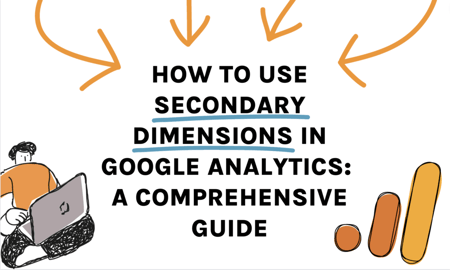SEO Analytics Revealed: Exploring Secondary Dimensions for Actionable Information
SEO Analytics Revealed: Exploring Secondary Dimensions for Actionable Information
Blog Article
Maximize Your Coverage Precision With Secondary Measurements
In the realm of data evaluation, the quest for precision and deepness is a continuous quest. Additional measurements provide an entrance to increasing reporting precision by supplying a diverse lens where to see data. Envision the power of unraveling detailed layers of info that lie beyond the surface metrics, supplying a richer tapestry of insights waiting to be checked out. As we start this trip of leveraging secondary measurements, the landscape of reporting precision beckons with assurances of boosted clearness and tactical decision-making.
Importance of Additional Measurements
Making use of secondary dimensions is essential for enhancing the depth and granularity of reporting insights in data analysis. By incorporating secondary dimensions into data evaluation procedures, services can acquire an extra comprehensive understanding of their efficiency metrics. These additional measurements supply an even more comprehensive view of the main information, permitting a much more nuanced interpretation of patterns and patterns. Secondary dimensions make it possible for experts to sector and filter data based on particular criteria, giving a much more customized and targeted analysis.
Furthermore, additional measurements assist in recognizing relationships and relationships that may not be right away obvious when examining data with only primary dimensions. This much deeper level of understanding can cause even more enlightened decision-making and strategic preparation within an organization. By leveraging secondary dimensions properly, companies can reveal concealed chances, pinpoint areas for renovation, and enhance their total efficiency.
Implementing Secondary Measurements
To incorporate secondary dimensions properly into information analysis processes, companies need to embrace a structured strategy that aligns with their coverage objectives and logical objectives. Carrying out additional dimensions entails selecting the best measurements that provide deeper insights right into primary information metrics.
Moreover, companies need to make sure that the picked additional dimensions relate to the main data and offer purposeful context without creating information overload. Implementing secondary dimensions additionally requires defining clear logical concerns that the added dimensions will certainly aid respond to. By structuring the application procedure around these factors to consider, businesses can take full advantage of the worth originated from secondary measurements and enhance the accuracy and depth of their reporting.
Analyzing Data With Additional Measurements

One secret aspect of examining data with secondary measurements is to make sure that the selected dimensions line up with your particular analytical goals. Selecting the right second dimensions can give context and nuance to your main data metrics, allowing you to attract even more exact conclusions and make educated choices based upon the understandings got.
Moreover, leveraging secondary measurements properly can aid in determining outliers, recognizing the influence of various variables on your crucial performance signs, and gaining an extensive view of your information landscape. By diving into data with second dimensions, you can improve the depth and high quality of your analysis, resulting in even more durable coverage and workable results.

Enhancing Insights Through Additional Measurements
Checking out discover here information through additional measurements not only deepens analysis but additionally magnifies the capacity for revealing valuable understandings that can dramatically improve reporting precision. By adding secondary measurements to your records, you can gain a much more extensive understanding of the connections between different information factors. This boosted viewpoint allows you to recognize patterns, patterns, and connections that might have been forgotten when assessing data with key dimensions alone.

Basically, leveraging additional dimensions empowers you to try here extract richer insights from your data, enabling you to make even more educated decisions and enhance your coverage accuracy.
Best Practices for Secondary Measurements
Making use of second dimensions properly needs mindful factor to consider of crucial techniques to enhance data evaluation and reporting accuracy. When executing secondary dimensions, it is vital to align them with your key metrics to derive meaningful insights. One finest method is to utilize secondary measurements sparingly, focusing on those that straight add to the particular evaluation goals. By staying clear of the lure to consist of too much measurements, you can preserve clearness in your reporting and prevent details overload.
Another important practice is to try out various combinations of secondary and key measurements to uncover special correlations and patterns within your information. This iterative method can disclose useful insights that may have been neglected otherwise. Additionally, it is very important to frequently examine and refine your secondary dimension selections to ensure they continue to be relevant and lined up with your progressing reporting needs.
Moreover, documenting the rationale behind your option of additional dimensions can offer Your Domain Name context for future analysis and assist in partnership within your team. By following these ideal practices, you can make best use of the efficiency of second measurements in enhancing your coverage accuracy and driving educated decision-making.
Verdict
Including secondary dimensions in data analysis is vital for optimizing reporting precision and acquiring deeper insights into efficiency fads. By strategically picking additional data factors, experts can make and discover surprise correlations notified choices. secondary dimensions. Carrying out finest techniques for second measurements enhances the depth of evaluation and enhances the importance of reporting outcomes. This strategy eventually leads to more exact and nuanced analyses of data, leading to even more informed decision-making.
Furthermore, secondary measurements help in recognizing connections and relationships that may not be immediately noticeable when assessing information with just main dimensions. Executing secondary dimensions includes picking the right dimensions that give much deeper understandings into key information metrics. Carrying out secondary measurements likewise requires specifying clear logical questions that the added measurements will assist answer.When evaluating information with second measurements, it is critical to concentrate on extracting important insights that complement key data metrics. By including second dimensions right into your evaluation, you can uncover patterns, trends, and partnerships that may not be noticeable when looking at the information from a primary dimension alone.
Report this page